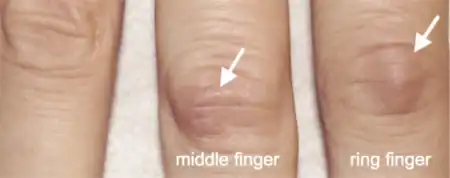Knuckle pads
| Knuckle pads | |
|---|---|
| Other names: Heloderma | |
 | |
| Knuckle pads (arrows) over the PIP joints | |
Knuckle pads (also known as "Heloderma", meaning similar to the skin of the Gila monster lizard for which it is named) are circumscribed, keratotic, fibrous growths over the dorsa of the interphalangeal joints.[1] They are described as well-defined, round, plaque-like, fibrous thickening that may develop at any age, and grow to be 10 to 15mm in diameter in the course of a few weeks or months, then go away over time.[2]
Knuckle pads are sometimes associated with Dupuytren's contracture[3] and camptodactyly,[2]: 595 and histologically, the lesions are fibromas.[2]: 595 [4] Knuckle pads are generally non-responsive to treatment, including corticosteroids, and tend to recur after surgery; however, there has been some effectiveness with intralesional fluorouracil.[5]
See also
References
- ↑ Mackey, SL; Cobb, MW (1994). "Knuckle pads". Cutis. 54 (3): 159–160. PMID 7813233.
- 1 2 3 James, WD; Berger, TG; Elston, DM (2005). Andrews' Diseases of the Skin: Clinical Dermatology (11th ed.). Saunders. p. 595. ISBN 0-7216-2921-0.
- ↑ Mikkelsen, Otto (October 1, 1977). "Knuckle Pads in Dupuytren's Disease". Journal of Hand Surgery. 9 (3): 301–305. doi:10.1016/S0072-968X(77)80121-6. PMID 608634. S2CID 7999131. Archived from the original on 31 October 2020. Retrieved 27 October 2020.
- ↑ Meinecke, R; Lagier, R (September 1975). "Pathology of "knuckle pads"". Virchows Archiv. 365 (3): 185–191. doi:10.1007/BF00434037. PMID 804749. S2CID 4518671. Archived from the original on 30 October 2020. Retrieved 27 October 2020.
- ↑ Weiss, E; Amini, S (2007). "A Novel Treatment for Knuckle Pads With Intralesional Fluorouracil". Arch Dermatol. 143 (11): 1447–1462. doi:10.1001/archderm.143.11.1458. PMID 18025384.
Further reading
- Guberman D; et al. (1996). ""Knuckle pads-a forgotten skin condition " report of a case and review of the literature". Cutis. 57 (4): 241–242. PMID 8727774.
- Ly Y; et al. (2003). "A novel mutation of keratin 9 in epidermolytic palmoplantar keratoderma combined with knuckle pads". Am J Med Genet. 120A (3): 345–9. doi:10.1002/ajmg.a.20090. PMID 12838553. S2CID 2717431.
- Peterson CM; et al. (2000). "Knuckle pads: does knuckle cracking play an etiologic role?". Pediatr Dermatol. 17 (6): 450–2. doi:10.1046/j.1525-1470.2000.01819.x. PMID 11123776. S2CID 22815331.
External links
| Classification | |
|---|---|
| External resources |